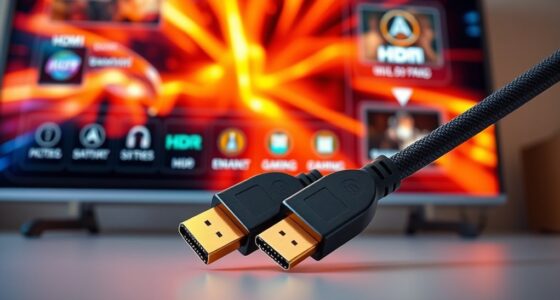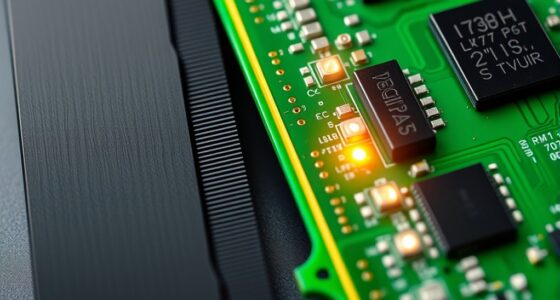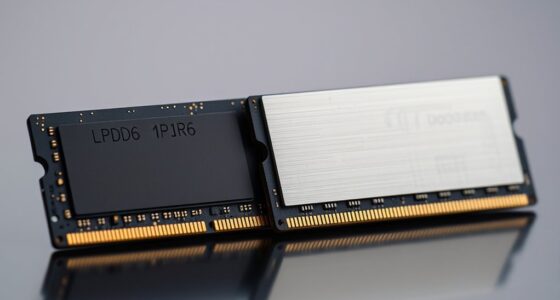Thread networking is a low-power, secure wireless protocol that helps your smart home devices communicate directly with each other without needing a central hub. It forms a resilient mesh network, allowing devices to connect through multiple pathways and reroute automatically if needed. With support from major smart home platforms, Thread enhances reliability, security, and energy efficiency. Curious about how it all fits together? Keep exploring to discover more about this innovative technology.
Key Takeaways
- Thread networking is a low-power, secure mesh protocol enabling smart home devices to communicate directly without central hubs.
- It creates a resilient network where devices connect via multiple pathways, allowing automatic rerouting if needed.
- Thread border routers connect the mesh to Wi-Fi or Ethernet, facilitating internet access and device management.
- Designed by industry leaders, it supports seamless device interoperability and future-proofing through IPv6 and encryption.
- Benefits include improved reliability, security, and energy efficiency for smart home device connectivity.
The Origins and Development of Thread Technology

Have you ever wondered how smart home devices communicate seamlessly? The story of Thread technology begins in 2014, when major companies like Google, Apple, and Samsung teamed up to create a reliable, low-power networking protocol. They aimed to improve device interoperability and simplify smart home setups. Unlike traditional Wi-Fi or Bluetooth, Thread was designed specifically for connected devices, offering a secure, scalable, and energy-efficient network. Over the years, it evolved through industry collaboration and technological innovation, gaining support from the Connectivity Standards Alliance. Today, Thread is a foundational element in many smart homes, enabling devices to communicate directly, quickly, and securely. Its development reflects a shared goal: making smart home technology more reliable, user-friendly, and integrated. Additionally, the protocol’s low-power design allows devices to operate efficiently over extended periods without frequent battery replacements.
Core Principles Behind Thread Networking

You’ll find that Thread networking relies on decentralized device communication, so no single point of failure can disrupt your smart home. It’s designed to consume very low power, helping your devices run longer without frequent recharges or replacements. Plus, its high reliability guarantees your devices stay connected and responsive at all times. Incorporating best wireless protocols can further optimize network performance and security.
Decentralized Device Communication
Decentralized device communication lies at the heart of Thread networking, enabling each device to connect directly with its neighbors without relying on a central hub. This setup creates a mesh network where data can hop from device to device until it reaches its destination. As a result, the network becomes more resilient; if one device fails, others can reroute data seamlessly. This peer-to-peer approach reduces latency and improves response times, making your smart home more responsive. It also enhances scalability, allowing new devices to join easily without complicated configurations. By eliminating a single point of failure, Thread guarantees your entire system stays connected and functional, even if individual devices go offline. Incorporating reliable communication solutions ensures consistent performance across your network. This decentralized structure forms the backbone of a reliable, flexible smart home network.
Low Power, High Reliability
At the core of Thread networking are principles that prioritize low power consumption and high reliability, ensuring your smart home stays connected without draining device batteries or sacrificing performance. Thread achieves this by using efficient protocols that minimize energy use and maintain stable connections even during network disruptions. Devices communicate quickly and securely, reducing latency and ensuring seamless operation. To illustrate, consider this overview:
| Principle | How It Works | Benefits |
|---|---|---|
| Low Power | Uses sleep modes and efficient protocols | Extends battery life of devices |
| Mesh Topology | Devices relay signals to each other | Improves network resilience |
| Secure Communication | End-to-end encryption | Protects your data |
| Self-Healing | Automatically reroutes connections | Maintains reliability |
| Scalability | Easily adds new devices | Supports expanding smart homes |
Additionally, interoperability between devices from different manufacturers is a key feature that enhances the versatility and ease of integration within your smart home ecosystem.
Key Features That Distinguish Thread From Other Protocols

Thread stands out from other smart home protocols primarily because of its robust mesh topology, which guarantees reliable and scalable communication among devices. This design allows each device to connect directly with multiple neighbors, creating multiple pathways for data. If one device fails or a connection drops, the network automatically reroutes data through alternative routes, ensuring uninterrupted performance. Additionally, Thread uses IPv6, enabling seamless integration with existing internet infrastructure and supporting future device expansion. Its low-power operation makes it ideal for battery-powered devices, extending their lifespan. The protocol also emphasizes security, employing AES encryption to protect data and prevent unauthorized access. These features collectively make Thread a resilient, flexible, and secure choice for smart home networking.
How Devices Communicate Using Thread

With Thread, your devices form a mesh network, allowing them to communicate directly with multiple neighbors. This setup guarantees reliable connections and extends coverage throughout your home. Plus, Thread is designed for low power use, so your devices stay connected longer without draining batteries. It also supports digital literacy by enabling smarter, interconnected device management that can be used to foster digital creativity and innovation within your household.
Mesh Network Structure
How do smart home devices communicate seamlessly across a network? They use a mesh network structure, which connects each device directly to multiple others. Instead of relying on a central hub, devices act as nodes, passing data through the most efficient path. If one device goes offline, others reroute the communication, ensuring the network stays reliable. This setup boosts coverage, allowing signals to hop from device to device until they reach their destination. It also enhances robustness; the network can self-heal if a node fails. With Thread’s mesh structure, your smart home becomes more resilient, flexible, and scalable. Devices work together smoothly, creating a unified ecosystem where commands and data flow effortlessly across the entire network.
Low Power Communication
Smart home devices need to communicate efficiently without draining their batteries, and Thread achieves this through low power communication. By using a technique called IEEE 802.15.4, Thread devices stay connected while conserving energy. They spend most of their time in sleep mode, waking only briefly to send or receive data. This approach reduces power consumption markedly, allowing devices to run on small batteries for years. Additionally, Thread uses efficient routing protocols that minimize unnecessary transmissions, further saving energy. As a result, your smart home devices remain responsive and reliable without frequent battery replacements. This low power communication makes Thread ideal for sensors, lights, and other devices that need to operate continuously without power constraints. You get a seamless, long-lasting smart home experience with minimal maintenance.
The Role of Thread Border Routers in Smart Homes

Thread border routers serve as essential gateways that connect the Thread mesh network to other IP-based networks, such as your home Wi-Fi or Ethernet. They guarantee seamless communication between your smart devices and the internet or cloud services. Without a border router, your Thread devices can’t interact with devices outside the mesh network or access updates. Here’s how they help:
- They translate data between the Thread network and external networks.
- They manage security by authenticating devices and encrypting data.
- They enable remote control and monitoring of your smart home devices via smartphone apps or cloud services.
- Network interoperability is achieved through the border router, allowing different protocols and devices to work together smoothly.
Benefits of Implementing Thread in Residential Settings

Implementing Thread in your home offers significant benefits, primarily through improved reliability and security for your smart devices. Thread’s mesh network ensures devices communicate directly and efficiently, reducing lag and connection drops. This stability means your smart home functions smoothly, even if a device or connection point fails. Additionally, Thread emphasizes security by using robust encryption, making it harder for malicious actors to access your network. Its low power consumption extends device battery life, minimizing maintenance. The decentralized architecture allows devices to operate autonomously, reducing dependence on a central hub. Moreover, the natural materials and rustic aesthetic of farmhouse design can be integrated into smart home decor, creating a cozy ambiance that complements modern technology. Overall, adopting Thread enhances your smart home’s performance, security, and energy efficiency, providing a seamless and dependable experience that keeps your connected devices working together effortlessly.
Compatibility and Ecosystem Support for Thread Devices

As the popularity of Thread grows, device compatibility and ecosystem support become essential considerations for homeowners. You want your smart home to work seamlessly, so understanding which devices and ecosystems support Thread is key.
Here’s what to look for:
- Device Compatibility: Ensure your smart devices, like lights or sensors, are Thread-enabled to avoid connectivity issues.
- Ecosystem Support: Check if your smart home hub or platform, such as Apple HomeKit or Google Nest, supports Thread to enable smooth integration.
- Future Proofing: Opt for devices and systems that are actively updating their firmware and expanding support for Thread, so your setup stays current.
Choosing compatible devices ensures a reliable, efficient smart home experience with minimal frustration.
Challenges and Limitations of Thread Networking

While compatibility and ecosystem support are improving, there are still notable hurdles that can hinder the adoption of Thread networking in your smart home. One challenge is limited device availability, as not all manufacturers have adopted the protocol, restricting your options. Additionally, the technology’s reliance on a stable power supply can be problematic for battery-powered devices, which may experience reduced performance or battery life. Network complexity can also be a barrier; setting up and troubleshooting Thread networks requires technical know-how, which might be intimidating for casual users. Moreover, existing Wi-Fi and Zigbee networks may interfere with Thread signals, causing connectivity issues. Lastly, the initial investment in compatible hardware can be higher, making it less accessible for some consumers. These factors can slow widespread adoption despite its advantages. Furthermore, the ongoing development of automation and connectivity standards influences how quickly Thread is integrated into mainstream smart home systems.
Future Trends and Innovations in Thread Technology

Looking ahead, advancements in Thread technology promise to make smart home networks more reliable, secure, and easier to use. You can expect several exciting innovations:
- Enhanced Security Features: Future updates will likely include stronger encryption and better threat detection, keeping your devices safer.
- Smarter Integration: Thread will seamlessly connect with other protocols like Zigbee and Z-Wave, creating a unified smart home experience.
- Improved Power Efficiency: New hardware designs will lower energy consumption, extending device battery life and reducing maintenance.
- Additional benefits include anti-aging effects and enhanced hydration, which can improve the overall functionality of connected devices and sensors.
These developments will simplify setup, boost reliability, and give you greater peace of mind. As Thread evolves, your smart home will become more intuitive, efficient, and resilient, paving the way for even more innovative automation.
Frequently Asked Questions
How Secure Is Thread Networking in Smart Homes?
You’re probably wondering about the security of Thread networking. It’s quite secure because it uses AES-128 encryption, which is very strong. Plus, each device gets its own unique keys, making unauthorized access difficult. The network also supports end-to-end security and frequent updates to patch vulnerabilities. Overall, you can trust Thread to protect your smart home devices, giving you peace of mind while enjoying seamless connectivity.
Can Existing Smart Home Devices Be Upgraded to Support Thread?
You wonder if you can upgrade your existing smart home devices to support Thread. While some newer devices are built with Thread compatibility, most older gadgets can’t be directly upgraded. However, you might add a Thread border router or gateway to connect your current devices to a Thread network, enhancing compatibility. Check your device specifications and consider adding a compatible hub to integrate older devices into the Thread ecosystem smoothly.
What Is the Typical Range of Thread-Enabled Devices?
Imagine a friendly neighborhood where your devices chat across the street with ease. That’s the typical range of Thread-enabled devices—about 10 to 30 meters indoors, similar to your living room or hallway. Walls and furniture might slow them down, but open spaces keep them connected. This reliable range guarantees your smart home stays responsive and cohesive, making everyday tasks seamless without needing extra boosters or hubs.
How Does Thread Handle Device Power Consumption?
Thread manages device power consumption efficiently by using low-power modes and optimized communication protocols. When your devices aren’t actively transmitting data, they switch to sleep mode, conserving energy. This means your smart home devices can run longer on batteries or less power, reducing energy costs and extending device lifespan. You’ll notice reliable performance without draining power quickly, making Thread ideal for energy-conscious smart home setups.
Are There Industry Standards for Thread Device Certification?
You might worry about compatibility, but yes, there are industry standards for Thread device certification. These standards guarantee your smart home devices work seamlessly together, regardless of the brand. Certified devices meet strict criteria for security, reliability, and interoperability. When you choose certified Thread products, you’re building a future-proof smart home that’s easy to expand and maintain, giving you peace of mind and confidence in your connected ecosystem.
Conclusion
As you weave Thread into your smart home tapestry, you create a resilient web that’s both flexible and strong. Like a well-orchestrated symphony, Thread harmonizes devices seamlessly, whispering intelligence through every corner. Embracing this technology means opening a door to a future where your home breathes with connected ease, transforming ordinary spaces into a living, breathing ecosystem. With Thread guiding your smart home journey, you’re crafting a symphony of innovation that’s truly in tune with tomorrow.









